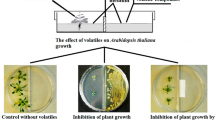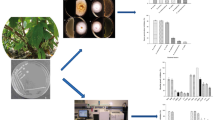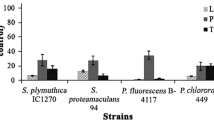Abstract
Increasing evidence indicates that volatile compounds emitted by bacteria can influence the growth of other organisms. In this study, the volatiles produced by three different strains of Burkholderia ambifaria were analysed and their effects on the growth of plants and fungi, as well as on the antibiotic resistance of target bacteria, were assessed. Burkholderia ambifaria emitted highly bioactive volatiles independently of the strain origin (clinical environment, rhizosphere of pea, roots of maize). These volatile blends induced significant biomass increase in the model plant Arabidopsis thaliana as well as growth inhibition of two phytopathogenic fungi (Rhizoctonia solani and Alternaria alternata). In Escherichia coli exposed to the volatiles of B. ambifaria, resistance to the aminoglycoside antibiotics gentamicin and kanamycin was found to be increased. The volatile blends of the three strains were similar, and dimethyl disulfide was the most abundant compound. Sulfur compounds, ketones, and aromatic compounds were major groups in all three volatile profiles. When applied as pure substance, dimethyl disulfide led to increased plant biomass, as did acetophenone and 3-hexanone. Significant fungal growth reduction was observed with high concentrations of dimethyl di- and trisulfide, 4-octanone, S-methyl methanethiosulphonate, 1-phenylpropan-1-one, and 2-undecanone, while dimethyl trisulfide, 1-methylthio-3-pentanone, and o-aminoacetophenone increased resistance of E. coli to aminoglycosides. Comparison of the volatile profile produced by an engineered mutant impaired in quorum-sensing (QS) signalling with the corresponding wild-type led to the conclusion that QS is not involved in the regulation of volatile production in B. ambifaria LMG strain 19182.






Similar content being viewed by others
References
Anadon A, Binderup M-L, Bursch W, Castle L, Crebelli R, Engel K-H, Franz R, Gontard N, Haertle T, Husoy T, Jany K-D, Leclercq C, Lhuguenot JC, Mennes W, Milana MR, Pfaff K, Svensson K, Toldra F, Waring R, Wolfle D, Sundh UB, Beltoft V, Carere A, Frandsen H, Gurtler R, Hill F, Larsen JC, Lund P, Mulder G, Norby K, Pascal G, Pratt I, Speijers G, Wallin H, Nielsen KR (2010) Flavouring group evaluation 8, Revision 2 (FGE.08rev2): aliphatic and alicyclic mono-, di-, tri-, and polysulphides with or without additional oxygenated functional groups from chemical groups 20 and 30. EFSA J 8:1408–1532
Baerlocher FJ, Langler RF, Fredriksen MU, Georges NM, Witherell RD (1999) Structure-activity relationships for selected sulfur-rich antifungal compounds. Aust J Chem 52:167–172
Baerlocher FJ, Baerlocher MO, Langler RF, MacQuarrie SL, Marchand ME (2000) New and more potent antifungal disulfides. Aust J Chem 53:1–5
Bailly A, Weisskopf L (2012) The modulating effect of bacterial volatiles on plant growth: current knowledge and future challenges. Plant Signal Behav 7:79–85
Bashkova S, Bagreev A, Bandosz TJ (2002) Effect of surface characteristics on adsorption of methyl mercaptan on activated carbons. Ind Eng Chem Res 41:4346–4352
Bernier SP, Letoffe S, Delepierre M, Ghigo JM (2011) Biogenic ammonia modifies antibiotic resistance at a distance in physically separated bacteria. Mol Microbiol 81:705–716
Blom D, Fabbri C, Connor EC, Schiestl FP, Klauser DR, Boller T, Eberl L, Weisskopf L (2011a) Production of plant growth modulating volatiles is widespread among rhizosphere bacteria and strongly depends on culture conditions. Environ Microbiol 13:3047–3058
Blom D, Fabbri C, Eberl L, Weisskopf L (2011b) Volatile-mediated killing of Arabidopsis thaliana by bacteria is mainly due to hydrogen cyanide. Appl Environ Microbiol 77:1000–1008
Campos VP, de Pinho RSC, Freire ES (2010) Volatiles produced by interacting microorganisms potentially useful for the control of plant pathogens. Cienc Agrotec 34:525–535
Chambers ST, Scott-Thomas A, Epton M (2012) Developments in novel breath tests for bacterial and fungal pulmonary infection. Curr Opin Pulm Med 18:228–232
Chernin L, Toklikishvili N, Ovadis M, Kim S, Ben-Ari J, Khmel I, Vainstein A (2011) Quorum-sensing quenching by rhizobacterial volatiles. Environ Microbiol Rep 3:698–704
Chin HW, Lindsay RC (1994) Ascorbate and transition-metal mediation of methanethiol oxidation to dimethyl disulfide and dimethyl trisulfide. Food Chem 49:387–392
Ciccillo F, Fiore A, Bevivino A, Dalmastri C, Tabacchioni S, Chiarini L (2002) Effects of two different application methods of Burkholderia ambifaria MCI 7 on plant growth and rhizospheric bacterial diversity. Environ Microbiol 4:238–245
Citron CA, Rabe P, Dickschat JS (2012) The scent of bacteria: headspace analysis for the discovery of natural products. J Nat Prod 75:1765–1776
Coenye T, Mahenthiralingam E, Henry D, LiPuma JJ, Laevens S, Gillis M, Speert DP, Vandamme P (2001) Burkholderia ambifaria sp nov., a novel member of the Burkholderia cepacia complex including biocontrol and cystic fibrosis-related isolates. Int J Syst Evol Microbiol 51:1481–1490
Curir P, Danieli B, Dolci M, Pasini C, Guglieri L, Sacco M (2000) Reductive detoxification of the acetophenone skeleton of the carnation phytoanticipin by Fusarium oxysporum f.sp dianthi. Plant Pathol 49:742–747
Dickschat JS, Helmke E, Schulz S (2005a) Volatile organic compounds from arctic bacteria of the Cytophaga-Flavobacterium-Bacteroides group: a retrobiosynthetic approach in chemotaxonomic investigations. Chem Biodivers 2:318–353
Dickschat JS, Wagner-Dobler I, Schulz S (2005b) The chafer pheromone buibuilactone and ant pyrazines are also produced by marine bacteria. J Chem Ecol 31:925–947
Dickschat JS, Wickel S, Bolten CJ, Nawrath T, Schulz S, Wittmann C (2010) Pyrazine biosynthesis in Corynebacterium glutamicum. Eur J Org Chem 2010:2687–2695
Effmert U, Kalderas J, Warnke R, Piechulla B (2012) Volatile mediated interactions between bacteria and fungi in the soil. J Chem Ecol 38:665–703
Faruk M, Rahman M, Mustafa M, Coosemans IJ (2012) Dimethyl disulfide- A potential biopesticide against root-knot nematode of tomato (Lycopersicon Esculentum L.). Bangladesh J Agric Res 36:685–695
Fernando WGD, Ramarathnam R, Krishnamoorthy AS, Savchuk SC (2005) Identification and use of potential bacterial organic antifungal volatiles in biocontrol. Soil Biol Biochem 37:955–964
Grayer RJ, Kokubun T (2001) Plant-fungal interactions: the search for phytoalexins and other antifungal compounds from higher plants. Phytochemistry 56:253–263
Gutierrez-Luna FM, Lopez-Bucio J, Altamirano-Hernandez J, Valencia-Cantero E, de la Cruz HR, Macias-Rodriguez L (2010) Plant growth-promoting rhizobacteria modulate root-system architecture in Arabidopsis thaliana through volatile organic compound emission. Symbiosis 51:75–83
Han SH, Lee SJ, Moon JH, Park KH, Yang KY, Cho BH, Kim KY, Kim YW, Lee MC, Anderson AJ, Kim YC (2006) GacS-dependent production of 2R, 3R-butanediol by Pseudomonas chlororaphis O6 is a major determinant for eliciting systemic resistance against Erwinia carotovora but not against Pseudomonas syringae pv. tabaci in tobacco. Mol Plant Microbe Interact 19:924–930
Ishibashi H, Takamuro I, Mizukami Y-I, Irie M, Ikeda M (1989) A convenient general access to α-sulfenylated acetophenones and alkanones. Synth Commun 19:443–452
Kai M, Piechulla B (2010) Impact of volatiles of the rhizobacteria Serratia odorifera on the moss Physcomitrella patens. Plant Signal Behav 5
Kai M, Vespermann A, Piechulla B (2008) The growth of fungi and Arabidopsis thaliana is influenced by bacterial volatiles. Plant Signal Behav 3:482–484
Kai M, Crespo E, Cristescu SM, Harren FJM, Francke W, Piechulla B (2010) Serratia odorifera: analysis of volatile emission and biological impact of volatile compounds on Arabidopsis thaliana. Appl Microbiol Biotechnol 88:965–976
Kim YC, Kim HJ, Park KH, Cho JY, Kim KY, Cho BK (2003) 3-methylthiopropanoic acid produced by Enterobacter intermedium 60-2G inhibits fungal growth and weed seedling development. J Antibiot 56:177–180
Lee HH, Molla MN, Cantor CR, Collins JJ (2010) Bacterial charity work leads to population-wide resistance. Nature 467:82–85
Li QL, Ning P, Zheng L, Huang JB, Li GQ, Hsiang T (2010) Fumigant activity of volatiles of Streptomyces globisporus JK-1 against Penicillium italicum on Citrus microcarpa. Postharvest Biol Technol 58:157–165
Lu SE, Novak J, Austin FW, Gu GY, Ellis D, Kirk M, Wilson-Stanford S, Tonelli M, Smith L (2009) Occidiofungin, a unique antifungal glycopeptide produced by a strain of Burkholderia contaminans. Biochemistry-Us 48:8312–8321
Mahenthiralingam E, Urban TA, Goldberg JB (2005) The multifarious, multireplicon Burkholderia cepacia complex. Nat Rev Microbiol 3:144–156
Müller H, Westendorf C, Leitner E, Chernin L, Riedel K, Schmidt S, Eberl L, Berg G (2009) Quorum-sensing effects in the antagonistic rhizosphere bacterium Serratia plymuthica HRO-C48. FEMS Microbiol Ecol 67:468–478
Nawrath T, Mgode GF, Weetjens B, Kaufmann SHE, Schulz S (2012) The volatiles of pathogenic and nonpathogenic mycobacteria and related bacteria. Beilstein J Org Chem 8:290–299
Noda T, Sato Z, Kobayashi H, Iwasaki S, Okuda S (1980) Isolation and structural elucidation of phytotoxic substances [for rice plant, Oryza sativa] produced by Xanthomonas campestris pv. oryzae (Ishiyama) Dye. Ann Phytopathol Soc Jpn 46:663–666
Pavlou AK, Turner APF (2000) Sniffing out the truth: clinical diagnosis using the electronic nose. Clin Chem Lab Med 38:99–112
Pessi G, Haas D (2000) Transcriptional control of the hydrogen cyanide biosynthetic genes hcnABC by the anaerobic regulator ANR and the quorum-sensing regulators LasR and RhlR in Pseudomonas aeruginosa. J Bacteriol 182:6940–6949
Pittard BT, Later DW, Lee ML, Freeman LR (1982) Identification of volatile organic-compounds produced by fluorescent pseudomonads on chicken breast muscle. Appl Environ Microbiol 43:1504–1506
Ryu CM, Farag MA, Hu CH, Reddy MS, Wei HX, Pare PW, Kloepper JW (2003) Bacterial volatiles promote growth in Arabidopsis. Proc Natl Acad Sci USA 100:4927–4932
Schmidt S, Blom JF, Pernthaler J, Berg G, Baldwin A, Mahenthiralingam E, Eberl L (2009) Production of the antifungal compound pyrrolnitrin is quorum sensing-regulated in members of the Burkholderia cepacia complex. Environ Microbiol 11:1422–1437
Schulz S, Dickschat JS (2007) Bacterial volatiles: the smell of small organisms. Nat Prod Rep 24:814–842
Schulz S, Fuhlendorff J, Reichenbach H (2004) Identification and synthesis of volatiles released by the myxobacterium Chondromyces crocatus. Tetrahedron 60:3863–3872
Scott-Thomas AJ, Syhre M, Pattemore PK, Epton M, Laing R, Pearson J, Chambers ST (2010) 2-Aminoacetophenone as a potential breath biomarker for Pseudomonas aeruginosa in the cystic fibrosis lung. BMC Pulm Med 10
Shatalin K, Shatalina E, Mironov A, Nudler E (2011) H2S: a universal defense against antibiotics in bacteria. Science 334:986–990
Tawfik KA, Jeffs P, Bray B, Dubay G, Falkinham JO, Mesbah M, Youssef D, Khalifa S, Schmidt EW (2010) Burkholdines 1097 and 1229, potent antifungal peptides from Burkholderia ambifaria 2.2N. Org Lett 12:664–666
Throup J, Winson MK, Bainton NJ, Bycroft BW, Williams P, Stewart GSAB (1995) Signalling in bacteria beyond luminescence. In: Campbell AK, Kricka LJ, Standley PE (eds) Bioluminescence and chemiluminescence: fundamental and applied aspects. Wiley, Chichester, pp 89–92
Velazquez-Becerra C, Macias-Rodriguez LI, Lopez-Bucio J, Altamirano-Hernandez J, Flores-Cortez I, Valencia-Cantero E (2011) A volatile organic compound analysis from Arthrobacter agilis identifies dimethylhexadecylamine, an amino-containing lipid modulating bacterial growth and Medicago sativa morphogenesis in vitro. Plant Soil 339:329–340
Vespermann A, Kai M, Piechulla B (2007) Rhizobacterial volatiles affect the growth of fungi and Arabidopsis thaliana. Appl Environ Microbiol 73:5639–5641
Voisard C, Keel C, Haas D, Defago G (1989) Cyanide production by Pseudomonas fluorescens helps suppress black root-rot of tobacco under gnotobiotic conditions. EMBO J 8:351–358
Wang C, Wang Z, Qiao X, Li Z, Li F, Chen M, Wang Y, Huang Y, Cui H (2013) Antifungal activity of volatile organic compounds from Streptomyces alboflavus TD-1. FEMS Microbiol Lett 341:45–51
Weise T, Kai M, Gummesson A, Troeger A, von Reuss S, Piepenborn S, Kosterka F, Sklorz M, Zimmermann R, Francke W, Piechulla B (2012) Volatile organic compounds produced by the phytopathogenic bacterium Xanthomonas campestris pv. vesicatoria 85–10. Beilstein J Org Chem 8:579–596
Weisskopf L, Bailly A (2013) Plant growth modulation by bacterial volatiles: a focus on Burkholderia species. In: Bruijn Fd (ed) Molecular microbial ecology of the rhizosphere. Wiley, Hoboken, New Jersey
Whitehead NA, Barnard AML, Slater H, Simpson NJL, Salmond GPC (2001) Quorum-sensing in gram-negative bacteria. FEMS Microbiol Rev 25:365–404
Zhao LJ, Yang XN, Li XY, Mu W, Liu F (2011) Antifungal, insecticidal and herbicidal properties of volatile components from Paenibacillus polymyxa strain BMP-11. Agric Sci China 10:728–736
Zhou H, Yao F, Roberts DP, Lessie TG (2003) AHL-deficient mutants of Burkholderia ambifaria BC-F have decreased antifungal activity. Curr Microbiol 47:174–179
Zou CS, Li ZF, Yu DQ (2010) Bacillus megaterium Strain XTBG34 promotes plant growth by producing 2-pentylfuran. J Microbiol 48:460–466
Acknowledgments
The authors are grateful to Prof. Dr. Katharina Riedel for initiating collaboration between S.S. and L.W. and for helpful discussions. We thank Dr. Aurélien Carlier for his valuable advice regarding construction of the bafI mutant. This research was partly funded by a Plant Science Centre-Syngenta Fellowship to A.B. and by the Swiss National Science Foundation (project 31003A-130089).
Author information
Authors and Affiliations
Corresponding authors
Additional information
Ulrike Groenhagen and Rita Baumgartner equally contributing authors.
Electronic Supplementary Material
Below is the link to the electronic supplementary material.
ESM 1
(DOC 2256 kb)
Rights and permissions
About this article
Cite this article
Groenhagen, U., Baumgartner, R., Bailly, A. et al. Production of Bioactive Volatiles by Different Burkholderia ambifaria Strains. J Chem Ecol 39, 892–906 (2013). https://doi.org/10.1007/s10886-013-0315-y
Received:
Revised:
Accepted:
Published:
Issue Date:
DOI: https://doi.org/10.1007/s10886-013-0315-y




